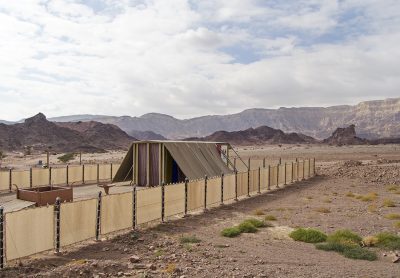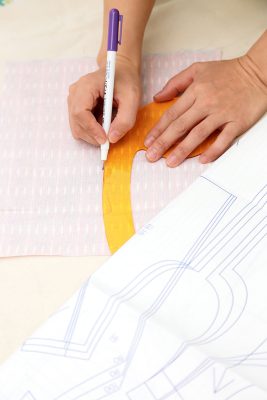×


We have detected your country as:
Please click here to go to the USA website or select another country from the dropdown list.
by: Rev. Rebecca J. Brimmer, International President and CEO
Each week, we join the Jewish world in reading the Torah (Gen.–Deut.) portion. The readings are divided in such a way that the entire Torah is read in a year. Jesus (Yeshua) and the disciples were well versed in the Torah and quoted from it frequently. I am not sure how you can understand the Writings of the Apostles (NT) without a firm foundation in the Torah and the rest of the Tanakh (OT). One of the Torah portions is called Terumah, and it is found in Exodus 25–27. The name Terumah means contributions, gifts or offerings. This portion begins a section of Scripture in which God gives detailed directions to build a Tabernacle including its furnishings.
Every big project has many phases from concept to completion. If you have ever built a house or been involved in a church building program, you have experienced it firsthand. After coming up with the concept, it is important to set some concrete goals. Often, the next step is to do an artist’s rendering of what the project will look like. Architects get involved in drawing up a blueprint. Then you must raise the money to build. Only then does the actual construction begin.
 Rabbi Jonathan Sacks wrote in answer to this question. “The Tabernacle was the first Israelite house of worship, the first home Jews made for God. But the very idea is fraught with paradox, even contradiction. How can you build a house for God? He is bigger than anything we can imagine, let alone build.”
Rabbi Jonathan Sacks wrote in answer to this question. “The Tabernacle was the first Israelite house of worship, the first home Jews made for God. But the very idea is fraught with paradox, even contradiction. How can you build a house for God? He is bigger than anything we can imagine, let alone build.”
King Solomon made this point when he built another house of God, the First Temple: “But will God indeed dwell on earth? Behold, heaven and the heaven of heavens cannot contain You. How much less this temple which I have built!” (1 Kings 8:27).
Isaiah also addressed this point, speaking words from the Almighty Himself: “Heaven is My throne, and earth is My footstool. Where is the house that you will build Me? And where is the place of My rest?” (Isa. 66:1).
Rabbi Sacks continued, “Not only does it seem impossible to build a home for God. It should be unnecessary. The God of everywhere can be accessed anywhere, as readily in the deepest pit as on the highest mountain, in a city slum as in a palace lined with marble and gold. The answer, and it is fundamental, is that God does not live in buildings. He lives in builders. He lives not in structures of stone but in the human heart. What the Jewish sages and mystics pointed was that in our parsha [Torah portion] God says, ‘Let them build me a sanctuary that I may dwell in them’ [Exod. 25:8 emphasis added], not “that I may dwell in it.”
After the debacle of the golden calf, when the people panicked because Moses was gone for six weeks, Jewish sources say that God decided that Israel needed a place to meet Him, a visual reminder of His presence.
Rabbi Sacks explained, “That is why God said to Moses, ‘Let them build me a sanctuary that I may dwell among them.’ The key word here is the verb sh-kh-n, to dwell. Never before had it been used in connection with God. It eventually became a keyword of Judaism itself. From it came the word Mishkan meaning a sanctuary, and Shekhinah, the divine presence. Central to its meaning is the idea of closeness. Shakhen in Hebrew means a neighbor, the person who lives next door. What the Israelites needed and what God gave them was a way of feeling as close to God as to our next-door neighbor.”
The whole idea of the Tabernacle was thus to get close to God. The richness of the Tabernacle and its furnishings were a constant reminder of the glory of God and His ability to provide for every need.
God gave specific instruction about how the Tabernacle should look and function. God loves being involved in the details.
Exodus 25:8–9 says, “And let them make Me a sanctuary, that I may dwell among them. According to all that I show you, that is, the pattern of the tabernacle and the pattern of all its furnis hings, just so you shall make it.”
hings, just so you shall make it.”
I am a seamstress. I used to make a lot of clothes for both Tom and I as well as gifts for others. My best efforts came when I carefully followed a pattern. Going off on my own design or even trying to copy a finished piece of clothing had haphazard results.
God didn’t leave the Tabernacle to chance. He gave very specific instructions for each piece of furniture and each part of its construction. Later in the Torah (Gen.–Deut.), there are references to the fact that Moses followed the pattern and this is referenced twice in the Writings of the Apostles (NT) in Acts and Hebrews. The Hebrew word used in Exodus 25:9 is tavnit, which can be translated as likeness, model, image, plan and form.
God’s patterns are not just reserved for building projects. He has a pattern for His children to live by. We find that pattern in the Bible. We walk in blessing to the degree that we do things His way. He lets us choose, but choosing to follow our own ideas results in consequences that are often very unpleasant and destructive to our own lives and to the community of which we are part.
When I followed the dress-making pattern—obviously created by someone more talented than me—it resulted in something beautiful and usable. If we would follow God’s pattern for living, I think we would discover the same thing: something beautiful and usable would be the result.
God didn’t only give Moses a vision. He also instructed him how to raise the funds to bring the vision to fruition. Every project must have a budget. Otherwise, it remains an unrealized dream. The first thing God did therefore was to direct Moses to raise funds for a Tabernacle, a mishkan. In Exodus 25:2–7, the offering is described in quite some detail.
First, God wanted the gifts to come from a willing heart. The Israelites were not forced to give. There was not a special tax that was imposed upon the people. They were not told a specific amount that they had to bring. The vision and the needs were communicated. “Speak to the children of Israel, that they bring Me an offering. From everyone who gives it willingly with his heart you shall take My offering” (Exod. 25:2).
The heart is important. God has always desired people who will love Him, worship Him and give to Him from a willing heart. 2 Corinthians 9:7 says “So let each one give as he purposes in his heart, not grudgingly or of necessity; for God loves a cheerful giver.”
There were, however, very specific things to be given in the freewill offering. You couldn’t just bring anything you wanted. There was a detailed list, which included: gold; silver; bronze; blue, purple and scarlet material; fine linen; goat hair, rams’ skins dyed red; porpoise skins; acacia wood; oil for lighting; spices for the anointing oil and fragrant incense as well as onyx stones and setting stones for the priest’s ephod and for the breast piece. Where in the world were the people who were traveling in the desert to obtain these valuable items?
When they left Egypt, the Lord told the Israelis to ask the Egyptians for wealth. “But every woman shall ask of her neighbor, namely, of her who dwells near her house, articles of silver, articles of gold, and clothing; and you shall put them on your sons and on your daughters. So you shall plunder the Egyptians” (Exod. 3:22).
That still leaves unanswered questions. How did the Israelites transport all this wealth? We know they had flocks. Perhaps they also had donkeys and camels. The acacia wood probably wasn’t so easy to transport, but they could have found that in the wilderness as they traveled.
Another Jewish tradition is that God had hidden the wealth of the Garden of Eden for this purpose, and He revealed its hiding place to Moses. That doesn’t really make sense to me, since if Moses had access to all the wealth, why ask the people to make the contribution?
God values every gift. Jesus (Yeshua) spoke well of the widow who gave a pittance but gave it with a willing heart. However, the Bible also doesn’t shy away from asking people to bring valuable gifts.
King David—when buying the threshing floor of Ornan—insisted on buying it rather than receiving it as a gift, saying, “For I will not take what is yours for the LORD, nor offer burnt offerings with that which costs me nothing” (1 Chron. 21:24b).
Numbers 18: 29 teaches, “Of all your gifts you shall offer up every heave offering due to the LORD, from all the best of them, the consecrated part of them.” This instruction refers to the sacrificial lambs which were to be without blemish
When we give to God, we also put ourselves in the place of blessing. Malachi 3:10–12: “‘Bring all the tithes into the storehouse, that there may be food in My house, and try Me now in this,’ says the LORD of hosts, ‘If I will not open for you the windows of heaven and pour out for you such blessing that there will not be room enough to receive it. And I will rebuke the devourer for your sakes, so that he will not destroy the fruit of your ground, nor shall the vine fail to bear fruit for you in the field,’ says the LORD of hosts; ‘And all nations will call you blessed, for you will be a delightful land,’ says the LORD of hosts.”
Offerings are not just money or things. When we give God our heart (willingly, without holding back) it puts us in the place to receive blessings from His hand.
Imagine how wonderful: God wants to dwell with us! The word for Tabernacle, mishkan, is related to the Hebrew word for neighbor. God wants to be close to us. The whole idea of the sacrifice system was to draw close. The word korban (sacrifice) has that connotation. It is related to the word for close relatives.
Psalm 91:1 says, “He who dwells in the secret place of the Most High shall abide under the shadow of the Almighty.”
Today, we don’t have a Tabernacle or Temple. How do we draw near to God? The main way we can dwell is to always make God and His word central in our hearts and lives. Let’s not live on the periphery. We should spend time with others who want to be near to God. The blessing is to be found in dwelling and abiding close to Him.
I hope you will remember these three concepts: pattern; giving; and dwelling. Let’s study to find God’s pattern for living godly lives. Blessing comes from living God’s way, not from willfully doing things our way.
Let’s give to fund His purposes and projects. At Bridges for Peace, God has directed us to show His love to the Jewish people in practical ways. While fundraising is not my favorite job, I am so blessed to see the way God’s people respond with willing hearts.
Dwelling with God, or abiding as Jesus spoke about in John 15, should be one of our chief delights. Let’s make a priority of spending time with God’s people, studying and listening to teaching, and devoting ourselves to worship, praise and prayer. Today is a good time to spend time with Him.
Photo Credit: Click on photo to see photo credit
Sacks, Rabbi Lord Jonathan. “The Gift of Giving.” Jonathan Sacks: The Rabbi Sacks Legacy. https://www.rabbisacks.org/covenant-conversation/terumah/the-gift-of-giving/
All logos and trademarks in this site are property of their respective owner. All other materials are property of Bridges for Peace. Copyright © 2024.
Website Site Design by J-Town Internet Services Ltd. - Based in Jerusalem and Serving the World.